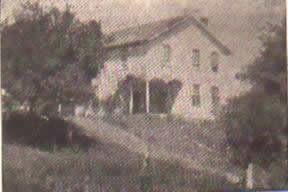Chapter VI
The Parsonage
CHAPTER VI
A very important question for
every Methodist charge, whether in city, village, or country, has always
been and will continue to be, a proper home for the Pastor, well located.
Some charges seems to think it of but little consequence
to the charge where the minister lives, or in what kind of home he dwells,
only asking that he be ready for duty, and in every time when called upon
be in a first-class condition to per- form the work demanded of hire.
They seem to overlook the fact that a preacher is like
all other human creatures’ better able to do good work in his line,
if properly fed and cared for, and his family supplied with the necessaries
of life and safely housed in a comfortable home. At least these things should
be a fair average with the people whom he serves. There is much need of a
general shaping up on this line in many places. There comes to mind now,
a beautiful parsonage house located on a very desirable corner in one of
the snug villages of Southern Ohio, but the well of water should cause the
mosquitoes, which would be silly enough to use it, to have an early
attack of malaria. Another lacks a coal shed and
-18-
a small building for a lumber-room.
Another is on an out-of-way street with no suitable walk leading from it.
And in all of these charges there are several persons, any one of whom could
make the necessary improvements and hardly fill the loss of money expended.
In the year 1860, Albert Gallatin Byers was pastor, and under
his administration the work of building the parsonage was begun and completed.
Mr. Samuel Wise was the boss carpenter, and was assisted by
the Gillingham boys. They did good work, for the building stands as solid today
as when first erected, and unless torn down to give place to a new one, or destroyed
by storm or fire, it will furnish a home for successive preachers and their families
for many generations to come.
The trustees were James H. Guthrie, Truman Guthrie, Grasson
Davis, Jacob Riggs and Thomas Roberts. D. L. Guthrie and Jacob Riggs were chosen
to superintend the work, and it is largely to their careful oversight that a
substantial and commodious building was erected at a cost of only about $800.
The building was planned by D. L. Guthrie. The cut at the
head of this chapter gives a fair view of the parsonage as seen from a point
about 200 feet southeast of the building. The size of the main building is 30x32
feet. There are four rooms above and three below.
Underneath the room diagonally opposite the porches is a small
cellar. This room was used for kitchen and dining room until Rev. J. D. Hathaway
became pastor. A festival held at the parsonage netted about $50. With this sum
he put up a small kitchen in the rear of the room preciously used as such. But
it was neither ceiled nor plastered it could not be used in cold weather. However,
this continued to be used until 1898. Then under the pastorate of the writer
a new one was erected at a cost of $100. It was designed by Mr. E. A. Riggs and
is 12x14 feet, with a porch 7x9 feet and a pantry 5x7 feet on the south side.
The cistern is under the porch, and is reached from a door
leading directly from the kitchen. The outside of the new building is weather
boarded while the inside is ceiled. The roof is of slate.
A short time previous to the erection of the new kitchen a
slate roof was put on the main building and new spouting took place of the old.
The cost was upwards of $55.
The money to erect the new building and to put on the slate
roof was raised in part by subscription and in part by the proceeds of two sale
stands at a Fourth of July gathering held in the grove of Bro. J, L. McDaniel,
just above Raccoon Bridge, in the same year.
A good stable and a moderately fair garden add to the conveniences
and advantages of the preacher’s home.
The present pastor and his good wife, Mr. And Mrs. J. F. Smith,
have given the interior a much needed and thorough renovation, repapering etc.,
making it one of the most comfortable parsonages in Southern Ohio. And they now
have the pleasure of enjoying it for another year, having just been returned
to Eureka circuit for a second year of service.
-19-

